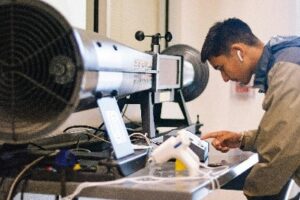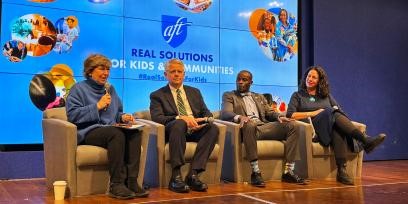The Promise of Career and Technical Education (CTE): Lessons from the American Federation of Teachers’ School Improvement Leadership Institute
By Aaron Leo and C. Fred Engelhardt Jr.
This January, educators, policymakers, and community members from across the country arrived in New York City for the Center for School Improvement (CSI) Leadership Institute held by the American Federation of Teachers (AFT). The theme of this year’s institute was “Real Solutions, Focusing on CTE.”
But what does CTE (Career and Technical Education) exactly mean? What are its benefits for students, the communities in which they live, and the wider society?
In this blog we briefly discuss some misconceptions about CTE and its promise for young people and the wider society. Then, Dr. C. Fred Engelhardt, Director of Grants and Program Development at Albany City School District and NYKids collaborator, will discuss some of his thoughts on CTE and share some takeaways from the CSI Institute this January.
What is CTE, and Why is it Important?
According to the Association for Career and Technical Education (ACTE), CTE “prepares secondary, postsecondary and adult students with technical, academic and employability skills for success in the workplace and in further education.”

However, negative stereotypes about CTE and the students who pursue CTE persist to this day: CTE (or what had previously been called “vocational-technical” education or “vo-tech”) has often been considered a lower track which is reserved for students who lack the academic skills needed for college.
Recent studies, however, tell a different story. For example, the Fordham Institute reports that students taking CTE courses are not only more likely to graduate high school but also have higher rates of employment and better wages than their peers who did not take CTE coursework. Contrary to popular notions, CTE does not steer students away from college; those taking CTE classes were found to be just as likely as their peers to pursue a four-year degree. Because CTE is naturally geared towards providing students with real-life, hands-on learning opportunities, it can also stimulate student engagement and critical thinking.
With these benefits in mind, it is unsurprising that the numbers of students participating in CTE pathways is on the rise. According to the U.S. Department of Education, 8.3 million high school students participated in CTE coursework in the 2020-2021 school year, an increase of over 10 percent from the previous year.
As advocates note, CTE benefits communities and the wider society as well as students. For instance, CTE can help address workforce shortages in many industries across the U.S. by providing young adults with the necessary skills to fill jobs in need of workers. Such “skills gaps” are common in many cities and rural communities with growing blue-collar industries that struggle to find enough workers with CTE training and skills.
NYKids Study of College and Career Readiness
NYKids’ College and Career Readiness study examining 7 positive outlier secondary schools provides evidence of the potential for CTE to support young adults after they graduate high school. For example, in this study we found that educators at these schools were interested in preparing their graduates not simply for college but for life after high school. While college readiness for all students was seen as a priority, educators at these schools wanted students to be well-rounded and have plenty of opportunities to pursue their interests. In many cases this meant giving students a variety of options to prepare them for careers as well as college. A guidance counselor from Port Chester summed up this viewpoint:
So, our [guidance counselors’] goal is to make sure that every student can be a productive citizen, and they have to tell us their plan. They just can’t get a diploma and walk out the door.
 In many of the schools we studied, educators tailored opportunities to meet the interests of students and address needs in the community. For instance, at Sherburne-Earlville, educators described building the agricultural program at their school in response to student interests and to fill gaps in the job market.
In many of the schools we studied, educators tailored opportunities to meet the interests of students and address needs in the community. For instance, at Sherburne-Earlville, educators described building the agricultural program at their school in response to student interests and to fill gaps in the job market.
Likewise, at Maple Grove, educators explained the need to expose all students to college while also giving students opportunities to reflect on their post-graduation goals and develop concrete plans to meet these aspirations – whether this involved postsecondary schooling, additional technical and trade training, or entering the workforce. The superintendent described their goals for students graduating from Maple Grove in the following way:
When [students] leave …the high school, are they ready to be successful in whatever they have chosen to do? We understand, in this day and age . . . you should know what you’re interested in, what you’re good at, some things you might have skills in, and some preparation here to help you then go further, whether it be college or trades or whatever you have in mind.
Building Bridges to Careers
This year’s Center for School Improvement Leadership Institute (CSI) focused on “how to build a better bridge between experiential learning and work through career and technical education, internships, and apprenticeships.” Sessions included keynote speakers from AFT leadership, panel discussions of school leaders of CTE-themed schools from the greater New York City area, governmental entities discussing funding opportunities for CTE and break-out sessions to allow school teams time for CTE planning. All sessions included conversations on how to increase the national conversation around CTE within K-12 education.

While much of the discussion at the institute focused on the financial benefits for students (e.g., immediate employment to higher paying jobs, low student debt, etc.), several conversations offered a different perspective on why CTE is important to K-12 education. During her keynote speech, Randi Weingarten, president of AFT, showed an interview with Wes Moore, the Governor of Maryland. Mr. Moore offered that “service learning” would help heal the political divide that is currently characterizing the United States. He argued that service-learning opportunities help build empathy and promote collaboration. Ms. Weingarten connected this idea to the promotion of CTE opportunities within K-12 education, noting the need for civic-mindedness along with career-readiness. The experiential learning that comes with CTE should not only lead to positive career outcomes and higher engagement in classroom learning but includes a potential for societal change.
The New York State Education Department (NYSED) began work building out CTE programming pre-COVID by adding College, Career, and Civic Readiness (CCCR) indicators for school accountability indicating that schools must go beyond college-readiness and also focus attention on career preparation and civic engagement. More recently, NYSED has created a formal recognition of civic engagement for students through a “Seal of Civic Readiness” distinction on high school diplomas. The hope is that policymakers continue this trend understanding that CTE cannot stand alone and there must be a consideration for the greater good.
As NYKids researchers gather data in our new study of positive outlier schools in New York State, we will share promising practices in CTE—stay tuned.
For more updates on our research , please subscribe to our bimonthly newsletter and reach out to us at nykids@albany.edu with feedback or questions. We also encourage you follow us on X, Instagram, Facebook, and LinkedIn.
